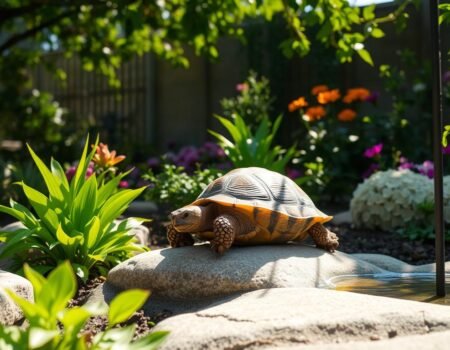Welcome to our guide on understanding the lifespan of your tarantula. If you’re a tarantula enthusiast or considering getting a pet tarantula, it’s important to have a good understanding of how long these captivating creatures live. We’ll explore the average lifespan of tarantulas, factors that can influence their longevity, and the importance of proper care. Let’s dive in!
Key Takeaways:
- Tarantulas have varying lifespans depending on the species, with females typically living longer than males.
- Factors such as proper care, enclosure conditions, and diet can significantly impact a tarantula’s lifespan.
- Common Brown Tarantulas can live up to 36 years, while Chilean Rose Hair Tarantulas have an average lifespan of 15 to 20 years.
- The Mexican Red Knee Tarantula can live up to 10 years for males and 25 years or more for females.
- The Brazilian Black Tarantula is often considered the “best pet tarantula” and can live up to 20 years.
Lifespan of the Common Brown Tarantula
The Common Brown Tarantula, also known as the Oklahoma brown or Texas brown tarantula, is a docile species of pet tarantula. With a leg span ranging from 4 to 5 inches, it is a moderate-sized tarantula that reaches maturity in 8 to 10 years. This species is popular among tarantula enthusiasts due to its long lifespan and non-aggressive temperament.
When properly cared for, the male Common Brown Tarantula can live between 7 and 12 years, while the female can have an impressive lifespan of up to 36 years. Providing the right conditions and meeting their specific needs are essential in ensuring their well-being and longevity.
As pet tarantulas, Common Brown Tarantulas require careful attention to their habitat and diet. Creating a suitable enclosure with the right temperature, humidity levels, and substrate is crucial for their overall health and stress reduction. In addition, offering hiding spots and environmental enrichment, such as branches or rocks for climbing, can mimic their natural habitat and promote their well-being.
Feeding a varied and balanced diet is also essential to ensure their nutritional needs are met. Common Brown Tarantulas primarily feed on insects and other small invertebrates. Providing a diverse range of live prey, such as crickets, mealworms, and roaches, allows them to obtain the necessary nutrients for growth and vitality.
It is important to note that while the Common Brown Tarantula is generally docile and non-aggressive, handling should be kept to a minimum to avoid stress or injury. Always prioritize safety and seek guidance from experienced tarantula keepers or arachnid experts if you have specific concerns or questions regarding tarantula care.
Lifespan of the Chilean Rose Hair Tarantula
The Chilean Rose Hair Tarantula is another fascinating species that is commonly kept as a pet. Known for its docile nature, this tarantula species is a favorite among beginners in the tarantula-keeping community. With an adult leg span ranging from 3 to 5 inches, females tend to be larger than males.
When it comes to the lifespan of the Chilean Rose Hair Tarantula, there is a noticeable difference between males and females. Female tarantulas can live up to an impressive 20 years, providing their owners with many years of companionship. On the other hand, male Chilean Rose Hair Tarantulas have a relatively shorter lifespan, typically living for around 4 to 5 years.
This species’ calm and relaxed temperament, coupled with its longer lifespan, make it an excellent choice for those looking for a low-maintenance pet. The Chilean Rose Hair Tarantula offers both beauty and longevity, making it a popular option in the world of pet tarantulas.
Lifespan of the Mexican Red Knee Tarantula
The Mexican Red Knee Tarantula is a fascinating species known for its striking appearance and gentle disposition. Its hairy black abdomen and vibrant orange to dark red-orange legs make it a visually captivating tarantula. Due to its docile temperament, the Mexican Red Knee Tarantula is a popular choice among pet enthusiasts.
This species has a leg span of 5 to 5.5 inches, making it a relatively large tarantula. The Mexican Red Knee Tarantula has a lifespan of up to 10 years for males and an impressive 25 years or more for females. These tarantulas can live a long and fulfilling life under proper care and favorable conditions.
Unfortunately, the Mexican Red Knee Tarantula is currently an endangered species. It has faced significant threats from the pet trade and habitat destruction. These factors have contributed to the decline in population numbers and the need for conservation efforts to protect this magnificent tarantula species.
Lifespan of the Brazilian Black Tarantula
When it comes to choosing a pet tarantula, the Brazilian Black Tarantula is often considered the best option. Known for its docile temperament and striking jet black color, this species is a favorite among tarantula enthusiasts.
The Brazilian Black Tarantula has a leg span of 5 to 6 inches, making it an impressive addition to any collection. In terms of lifespan, female Brazilian Black Tarantulas can live up to 20 years, while males have a significantly shorter lifespan. This means that if you’re looking for a long-term companion, a female Brazilian Black Tarantula is an excellent choice.
This species is also known for its high activity levels compared to other tarantula species. Watching the Brazilian Black Tarantula exploring its enclosure can be a fascinating experience. However, it’s important to note that this increased activity comes with a higher price tag compared to other tarantulas.
Overall, if you’re seeking a pet tarantula with a long lifespan and a captivating appearance, the Brazilian Black Tarantula is an excellent choice. Its docile nature and beautiful black color make it a favorite among tarantula enthusiasts.
Key Points:
- Brazilian Black Tarantulas are often considered the best pet tarantulas due to their docile temperament.
- Female Brazilian Black Tarantulas can live up to 20 years, while males have a significantly shorter lifespan.
- This species is more active than other tarantulas.
Factors Affecting Tarantula Lifespan
When it comes to tarantulas, several factors can significantly impact their lifespan. As responsible pet owners, it is our duty to provide the best care possible for these fascinating creatures. Let’s explore the key factors that play a crucial role in determining their longevity.
Proper Care and Maintenance
Providing proper care and maintenance is paramount to ensuring a tarantula’s well-being and lifespan. This includes creating suitable enclosure conditions that mimic their natural habitat. Maintaining the right temperature, humidity, and substrate are essential for their overall health and longevity.
A Balanced and Nutritious Diet
A tarantula’s diet is crucial for its health and longevity. These carnivorous creatures thrive on a diet consisting of live prey. Feeding them a variety of insects such as crickets, roaches, and mealworms ensures they receive the necessary nutrients for optimal growth and development.
Stress-Free Living Conditions
Creating a stress-free environment is vital for maximizing a tarantula’s lifespan. Minimizing disturbances and providing them with hiding spots and ample space for exploration can help alleviate stress and promote their overall well-being.
Regular Veterinary Care
Just like any other pet, tarantulas benefit from regular veterinary care. Regular check-ups can help identify any underlying health issues and ensure early intervention, leading to a longer and healthier life for your tarantula.
Accident Prevention and Safety
Accidents or injuries can significantly impact a tarantula’s lifespan. Taking precautions to create a safe enclosure, free from sharp objects or potential hazards, can help prevent accidents and promote a longer life for your tarantula.
“By understanding and addressing these factors, we can ensure that our tarantulas live long, healthy lives, bringing us joy and companionship for years to come.”
| Factors | Impact on Tarantula Lifespan |
|---|---|
| Proper Care and Maintenance | Significantly improves lifespan |
| A Balanced and Nutritious Diet | Essential for health and longevity |
| Stress-Free Living Conditions | Promotes overall well-being and extends lifespan |
| Regular Veterinary Care | Identifies and addresses health issues |
| Accident Prevention and Safety | Minimizes risks and ensures a longer life |
Understanding Female Tarantulas’ Longer Lifespan
Female tarantulas have a longer lifespan compared to males. This is primarily due to their mating behavior, where males have a shorter life span as their main purpose is to mate and reproduce. Females, on the other hand, can mate multiple times and are responsible for laying eggs. Female tarantulas also tend to be larger and healthier, contributing to their longer lifespan. Furthermore, tarantulas kept in captivity generally live longer than their wild counterparts due to better care and protection from predators.
Size and Health
One of the factors that contribute to the longer lifespan of female tarantulas is their size and health. Female tarantulas are usually larger than males, which can be advantageous in terms of overall nutrient storage and resilience. The larger size allows females to have more energy reserves and withstand stressors that males may struggle with. Additionally, female tarantulas’ reproductive system supports their longer lifespan, as the energy invested in egg production often leads to healthier individuals.
Captivity vs. Wild
Tarantulas kept in captivity generally have a longer lifespan compared to those in the wild. In captivity, tarantulas receive consistent care, including access to a suitable habitat, proper feeding, and protection from predators. These favorable conditions can significantly enhance the lifespan of female tarantulas and ensure their overall well-being.
| Average Lifespan (in years) | |
|---|---|
| Female Tarantulas in Captivity | Varies (depending on the species, up to several decades) |
| Female Tarantulas in the Wild | Varies (depending on the species, generally shorter than those in captivity) |
Factors Determining Lifespan
Several factors contribute to determining the lifespan of female tarantulas. These factors include:
- Species: Different tarantula species have varying lifespans, with some living significantly longer than others.
- Habitat: The quality of the tarantula’s habitat, including temperature, humidity, and substrate, can influence its lifespan.
- Food and Nutrition: A balanced and nutrient-rich diet is crucial for the overall health and longevity of female tarantulas.
- Stress Levels: Reduced stress levels, such as from predation risk or environmental disturbances, can positively impact a tarantula’s lifespan.
By understanding these factors and providing appropriate care, tarantula enthusiasts can help ensure the longevity of female tarantulas in their care.
“The longer lifespan of female tarantulas can be attributed to their ability to mate multiple times and their larger size and healthier overall condition. Additionally, tarantulas kept in captivity tend to live longer due to the optimal care and protection they receive.”
Optimizing Tarantula Lifespan through Proper Enclosure
Creating an optimal enclosure is crucial for ensuring the long lifespan of your pet tarantula. A well-designed habitat provides the necessary conditions for your tarantula to thrive and exhibit its natural behaviors. Here are some key factors to consider when setting up the perfect tarantula enclosure:
Temperature
Maintaining the right temperature range is essential for the well-being of your tarantula. Most species thrive in temperatures between 70°F and 85°F (21°C to 29°C). To achieve this, you can use a combination of heating methods like under-tank heating pads or heat lamps with thermostats to regulate the temperature effectively.
Humidity
Proper humidity levels are vital to mimic the tarantula’s natural environment and promote overall health. Depending on the species, humidity requirements can vary, so it’s important to research the specific needs of your tarantula. Monitoring humidity levels with a hygrometer and providing occasional misting or a water dish can help maintain optimal humidity.
Hiding Areas
Creating hiding areas within the enclosure is crucial for reducing stress and providing a sense of security for your tarantula. You can add various hiding spots, such as flower pots, cork bark, or commercially available hides, in different areas of the enclosure. These hiding areas help replicate the natural environment and encourage natural behaviors.
Substrate
Choosing the right substrate is important for the tarantula’s comfort and well-being. A soft and absorbent substrate, such as coconut coir or peat moss, provides a suitable surface for burrowing and helps maintain the proper humidity levels within the enclosure.
Climbing Opportunities
Many tarantula species are skilled climbers, so providing opportunities for climbing can enrich their environment. Carefully arranging rocks or branches within the enclosure can offer vertical spaces for your tarantula to explore and exhibit its natural behaviors.
Safety Precautions
Ensuring the safety of your tarantula is a top priority. Avoid using toxic plants or substrates, as they can be harmful to your pet. Additionally, securing the enclosure with proper locks or latches can prevent accidental escapes and protect your tarantula from potential dangers in the surrounding environment.
By following these guidelines and providing a well-designed and suitable enclosure, you can optimize your tarantula’s lifespan and create a thriving habitat for your beloved pet.
Considering Tarantulas as Pets
Tarantulas can make fascinating and unique pets for those looking for a low-maintenance companion. With their long lifespan and diverse species selection, tarantulas are an appealing choice for pet enthusiasts.
However, it’s important to note that tarantulas require specialized care and are not typical pets. Before bringing a tarantula into your home, it’s essential to research and consider various factors, such as their lifespan, temperament, and specific care needs.
When selecting a tarantula as a pet, it’s crucial to choose a species that aligns with your lifestyle and preferences. Some species of tarantulas are more docile and easier to handle, while others may have specific requirements or temperaments that may not suit everyone.
Researching the specific needs of different tarantula species will help you make an informed decision. Consider factors such as the tarantula’s lifespan, size, activity level, and any specialized care requirements they may have. This will ensure that you can provide the necessary environment and care for your tarantula to thrive.
Pros of Tarantulas as Pets
- Long lifespan: Tarantulas can live for several years, providing you with a long-lasting and rewarding pet relationship.
- Low-maintenance: Tarantulas are relatively low-maintenance pets compared to traditional animals like dogs or cats.
- Fascinating behavior: Observing a tarantula’s natural behavior and unique adaptations can be both mesmerizing and educational.
- Wide range of options: There is a diverse selection of tarantula species to choose from, each with its own distinct characteristics.
Cons of Tarantulas as Pets
- Specialized care requirements: Tarantulas have specific needs regarding enclosure setup, temperature, humidity, and diet.
- Limited interaction: Tarantulas are not pets that thrive on frequent handling or physical interaction.
- Fear or discomfort: Some individuals may have an innate fear or phobia of spiders, which can make owning a tarantula uncomfortable for them.
- Not suitable for young children: Tarantulas are delicate creatures and should only be handled by older children or adults under proper supervision.
By understanding the unique considerations of owning a tarantula and selecting the right species that suits your lifestyle and preferences, you can enjoy the fascinating world of tarantulas as pets.
| Tarantula Species | Lifespan | Maintenance Level | Temperament |
|---|---|---|---|
| Common Brown Tarantula | Up to 36 years | Low | Non-aggressive |
| Chilean Rose Hair Tarantula | Up to 20 years | Low | Docile |
| Mexican Red Knee Tarantula | Up to 25 years or more (females) | Moderate | Non-aggressive |
| Brazilian Black Tarantula | Up to 20 years (females) | Moderate | Docile |
Conclusion
Owning a tarantula as a pet can be a fascinating and rewarding experience. We now understand the lifespan of tarantulas and the factors that contribute to their longevity, ensuring we can provide them with the best care possible. By creating a suitable enclosure, offering a nutritious diet, and ensuring a stress-free environment, tarantula owners can enjoy the companionship of these unique creatures for many years. It is crucial to conduct thorough research and consult with experts to ensure the well-being and longevity of your pet tarantula.
When it comes to creating an optimal enclosure, we must consider factors such as temperature, humidity, hiding areas, substrate, and climbing opportunities. Maintaining the right temperature range and humidity levels, providing adequate hiding places, and using a suitable substrate like coconut coir are essential for reducing stress and promoting natural behaviors. Additionally, offering climbing opportunities with well-arranged rocks will keep our tarantulas active and engaged while ensuring their safety.
Remember, tarantulas are not your typical pets, but understanding their unique care needs will help us make informed decisions when selecting a species. Each species has its own lifespan, temperament, and care requirements. Conducting thorough research and consulting with experts will guide us in choosing the right tarantula that aligns with our preferences and level of experience. Through our dedication to their well-being and longevity, we can enjoy the fascinating companionship of these incredible creatures for many years to come.
FAQ
What is the lifespan of a tarantula?
Tarantulas have varying lifespans depending on the species. Females generally live longer than males. Certain species, such as the Common Brown Tarantula, can live up to 36 years in ideal conditions. Other species, like the Chilean Rose Hair Tarantula, have an average lifespan of 15 to 20 years.
How long do Common Brown Tarantulas live?
The Common Brown Tarantula, also known as the Oklahoma brown or Texas brown tarantula, can live up to 36 years with proper care. Males typically live 7 through 12 years, while females can live up to 36 years.
What is the lifespan of a Chilean Rose Hair Tarantula?
The Chilean Rose Hair Tarantula has an average lifespan of up to 20 years for females. Males have a shorter lifespan of 4 to 5 years.
How long do Mexican Red Knee Tarantulas live?
Mexican Red Knee Tarantulas can live up to 10 years for males and 25 years or more for females.
What is the lifespan of a Brazilian Black Tarantula?
Female Brazilian Black Tarantulas can live up to 20 years, while males have a shorter lifespan.
What factors can affect a tarantula’s lifespan?
Several factors can impact a tarantula’s lifespan, including proper care, enclosure conditions, diet, stress-free living, regular veterinary care, and avoiding accidents or injuries.
Why do female tarantulas live longer than males?
Female tarantulas have a longer lifespan compared to males due to their mating behavior and size and health differences. Males have a shorter lifespan as their main purpose is to mate and reproduce.
How can I optimize a tarantula’s lifespan through proper enclosure?
Creating an optimal enclosure for a tarantula involves providing suitable temperatures, humidity, hiding areas, substrate, and climbing opportunities. Safety precautions should also be taken to prevent falls or injuries.
Are tarantulas good pets?
Tarantulas can make good pets for those interested in these unique creatures. Their long lifespan, relatively low maintenance requirements, and varied species options make them appealing to pet enthusiasts. However, proper research and understanding of their specific needs are essential.
How should I care for a pet tarantula to ensure its longevity?
To care for a pet tarantula and ensure its longevity, it’s important to provide proper enclosure conditions, a balanced diet, stress-free living, and regular veterinary care. Thorough research and consultation with experts are recommended.









No Comment! Be the first one.